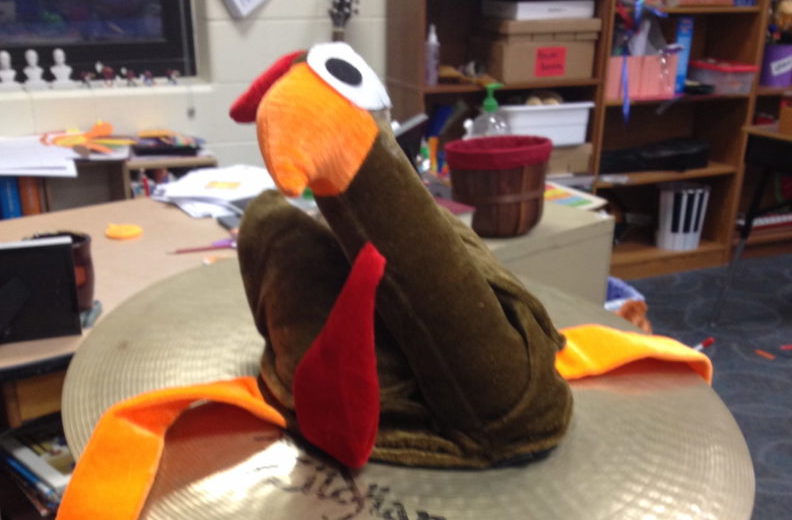
As I Came Over Yonder Hill – Song for November
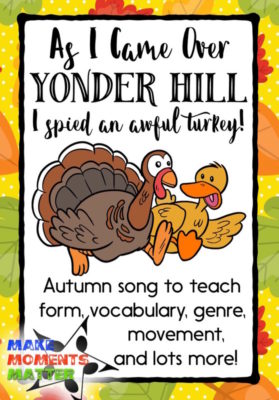 I love finding old and unique folk songs to share with my kiddos. Folk songs are so fun and quirky and not your typical elementary school fare. I mean, if you search “elementary school thanksgiving songs” you’ll find lots of songs that are used by teachers in general education classrooms to teach counting, math concepts, or basic writing skills. You’ll also find a lot of outdated and potentially racist songs about Native Americans. Take five minutes looking into the history of “10 Little Indians” and you’ll absolutely hesitate before you teach it again. Some of the Thanksgiving songs in our music textbooks are good, but how many times can you do “Five Fat Turkeys” with kids before they (and you) pull your hair out?
I love finding old and unique folk songs to share with my kiddos. Folk songs are so fun and quirky and not your typical elementary school fare. I mean, if you search “elementary school thanksgiving songs” you’ll find lots of songs that are used by teachers in general education classrooms to teach counting, math concepts, or basic writing skills. You’ll also find a lot of outdated and potentially racist songs about Native Americans. Take five minutes looking into the history of “10 Little Indians” and you’ll absolutely hesitate before you teach it again. Some of the Thanksgiving songs in our music textbooks are good, but how many times can you do “Five Fat Turkeys” with kids before they (and you) pull your hair out?
Folk songs are tried and true songs that have lasted for hundreds of years because the melody is good, the words are catchy, and the song is often connected with a dance/movement/game. They come from a different time and different age when getting together with friends and neighbors to sing and dance was expected. When teaching folk songs the connections to history and culture are endless. If you spend just 5 minutes of each lesson talking about some of those connections you can quickly help kids understand more about their history and culture.
This song I want to share with you today, “As I Came Over Yonder Hill,” is one of my new favorite Thanksgiving songs because it has some great vocabulary connections, uses a MINOR tonality, provides some easy connections for movement and partner fun, and is generally a blast for kids!
As I Came Over Yonder – Learning the Music
To teach this song I follow my usual process of singing the entire thing for kiddos and then “chunking” it out. So, I sing them the whole song as they listen and then I teach them by rote, singing one phrase at a time. My kiddos picked this up pretty quickly even though the song was brand new and in a minor tonality. With this particular song I decided to sing the “verse” or A section and teach them that before going on to the “la la la” of the B section/chorus.After they heard and sang through the A section I asked them to think about a word that they heard repeated a few times that might stick out for them. “You might have heard this word before, but we are using it in a different sort of way in this song.” Some kids raise their hand and identify the word “yonder” and I take a second to explain what that means and how it’s used. Then usually I have a kid who says the word “awful.” I love that this song uses two different meanings for “awful” because it really gets kids thinking. I show them this slide (below) and explain that awful could mean “terrible/bad” or it could mean “very.” I use the example sentences: “That dirty pig smells awful!” and also “The dessert was awful tasty!” The kids hear and understand the clear difference between these meanings even though most of my kiddos have never heard “awful” used to give emphasis.
 Then I ask students to decide which meaning of the word awful is used in each phrase of the song. “As I came over yonder hill I spied an awful turkey.” They usually think this means a bad turkey. “He flapped his wings and he spread his tail and his feet were awful dirty.” They recognize this as the other use of “awful” and I cannot tell you how many smiles of understanding I see when they “get it” and understand this new use of vocabulary. It’s an “Ah-ha” moment and it’s so wonderful to see.
Then I ask students to decide which meaning of the word awful is used in each phrase of the song. “As I came over yonder hill I spied an awful turkey.” They usually think this means a bad turkey. “He flapped his wings and he spread his tail and his feet were awful dirty.” They recognize this as the other use of “awful” and I cannot tell you how many smiles of understanding I see when they “get it” and understand this new use of vocabulary. It’s an “Ah-ha” moment and it’s so wonderful to see.
Then I quickly teach them the B section or “la la la” chorus. This part really feels more minor than the A section, but my kiddos picked it up pretty easily anyway. There is an alternate chorus option that replaces “la la la” with the pretty silly nonsense “Fol-link-a-ti-dy.” I usually don’t teach the song to students with those words or if I do, I save that for day two when they know the song already and can make the change without spending too much time on it.And side note, I love that this song is minor. It’s not a sad or scary song. It’s not your typical minor example and it exposes kids to something different and unique. LOVE!
Adding Actions and Improvised Movement
As we’re learning the phrases of the A section I add some VERY basic actions like pointing off into the distance for “over yonder hill” and putting my hands on hips and making a face for “awful turkey.” We obviously “flap our wings” and fan out our hands behind our head for “spread his tail” and point at our shoes for “his feet were awful dirty.” These are quick and easy/basic actions to add in with kiddos as you learn the song. Most of the time they’ll think of fun modifications or other ideas that are great to add in.Then once I teach the chorus/part B of the song with the nonsense “la la la” I ask them what actions we could include for that new part. When you have words like “flap his wings and spread his tail” you can easily imagine a movement that fits, but what to do when there aren’t words like that? I posed the question to my kiddos and got some AMAZING responses. One girl said that we could act like we’re talking about the turkey with a partner as if the words were “blah blah blah” instead of “la la la” and we were continuing a conversation. Another person thought we could skip around arm-in-arm with a partner. One students suggested that we could hop. Someone else thought we might dab. One kiddo even suggested we add in a do-si-do. After each suggestion we sang and tried out the new action to see how it might fit.
Once we had about 5 completely different suggestions I told kids that they got to partner up and decide what THEY wanted to do. Each little duet chose one of the actions that we practiced and there were tons of smiles as some people skipped, some dabbed, some “talked,” and some went off script to do something completely different. Then we put it all together and added back the A section where they did our prescribed actions along with the new movement for the B section.
Part C – The Turkey Strut!
 Just to make this even more fun, I added in something completely new and NOT part of the original song. I told the kids that after we sang Part A with actions and Part B with a partner that I was going to add in something different. I showed them this slide with the turkey strutting. We made the connection with turkeys and peacocks and other birds who fluff out their feathers and do things to get attention. I talked about the hallway of our school and what would happen if a student didn’t just walk through the hallway but strutted down the hall to their class. You would absolutely notice them! I showed them a normal walk and then puffed out my chest and strutted through the music room.Then I sat down at the piano and said that I was going to play some “strutting music” for them to walk to. I played the basic chord structure of the song without the melody as a little interlude and the kids were encouraged to “strut like a turkey” through the room. As a final twist, I told them that as the interlude music stopped they had to find a NEW partner and do the A and B sections with this new person. The kids could chose to do a different action for the B section if they wanted to.
Just to make this even more fun, I added in something completely new and NOT part of the original song. I told the kids that after we sang Part A with actions and Part B with a partner that I was going to add in something different. I showed them this slide with the turkey strutting. We made the connection with turkeys and peacocks and other birds who fluff out their feathers and do things to get attention. I talked about the hallway of our school and what would happen if a student didn’t just walk through the hallway but strutted down the hall to their class. You would absolutely notice them! I showed them a normal walk and then puffed out my chest and strutted through the music room.Then I sat down at the piano and said that I was going to play some “strutting music” for them to walk to. I played the basic chord structure of the song without the melody as a little interlude and the kids were encouraged to “strut like a turkey” through the room. As a final twist, I told them that as the interlude music stopped they had to find a NEW partner and do the A and B sections with this new person. The kids could chose to do a different action for the B section if they wanted to.
Making this little change and adding an interlude gives students the chance to move/hear a song where there’s a musical but non-singing interlude. It also means that you can go through the song several times and kids can cycle through partners and find new people to work with.
Other Connections and Variations
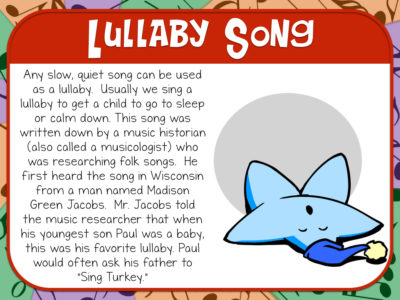 If we have a few minutes at the end of the class I let the kiddos sit down and I go through some of the slides that maybe I missed during instruction. We talk about the state where the song came from and I show them on the map how Wisconsin is adjacent to Michigan. They love that the song was written down in a place so close to them! Then we talk about the history and we go through to talk about turkeys and why they’re connected with the U.S and Thanksgiving.
If we have a few minutes at the end of the class I let the kiddos sit down and I go through some of the slides that maybe I missed during instruction. We talk about the state where the song came from and I show them on the map how Wisconsin is adjacent to Michigan. They love that the song was written down in a place so close to them! Then we talk about the history and we go through to talk about turkeys and why they’re connected with the U.S and Thanksgiving.
There’s one slide that talks bout Benjamin Franklin and why he thought the turkey should be our national bird. There’s a quote in the slides form Alexander Hamilton about eating turkey on thanksgiving and I had more than one student light up at the mention of this name.We also talk about this song functioning as a lullaby. Asher E. Treat, the musicologist who first wrote this song down, said that the song was sometimes used to put children to bed. The song is pretty high-energy when used in my classroom so the kids and I talk about how we could change the song to make it sweet and quiet to put a child to bed. I grab my uke or guitar and play the music quietly while the kids sing the song in a soft and easy way. They really seem to understand how this could be used as a lullaby when we sing the B section (la, la, la) in a quiet and soft way. Again, I usually see some “ah-ha” moments in the kids’ eyes!
I hope you had fun reading about how I introduce and play around with this fun little folk song. There are endless opportunities for “what comes next” with this song. If you have any other ideas of how to extend the lesson, please leave them in the comments below so that we can all gain ideas for the next time we teach this song!If you liked the visuals and resources you saw in the above blog post then check out this Favorite Folk Song Set for the song. I have it available to download as a PowerPoint presentation and also as JPEG files. Included in the set are a lot more pages of historical context, vocabulary, background for the song, visuals, and aids for teaching. You can use the PowerPoint for visuals and explanation as you teach or you can post the images out in the hallway as a bulletin board that reinforces the content you teach in class (or you can do both)!



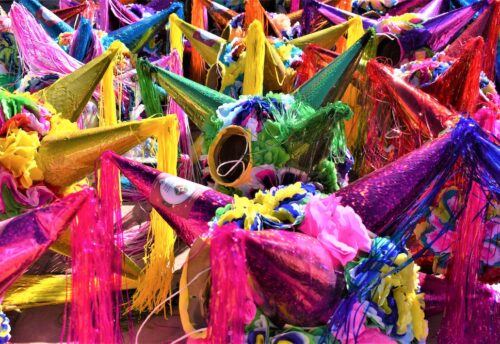
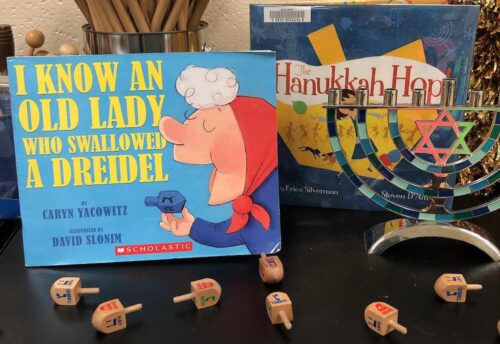
4 Comments